 |
New York
Architecture Images-Brooklyn Jones Beach Long Island |
||||||||||||
|
architect |
Public Works, supervised by Commission President Robert Moses | ||||||||||||
|
location |
Wantagh, New York 11793 | ||||||||||||
|
date |
1929 | ||||||||||||
|
style |
Art Deco | ||||||||||||
|
construction |
brick, stone | ||||||||||||
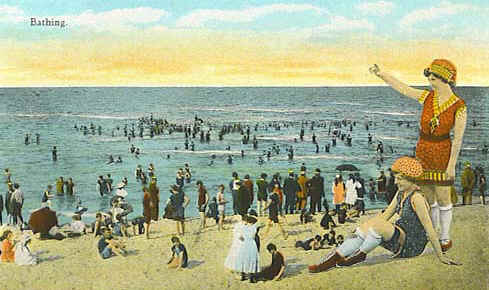 |
|||||||||||||
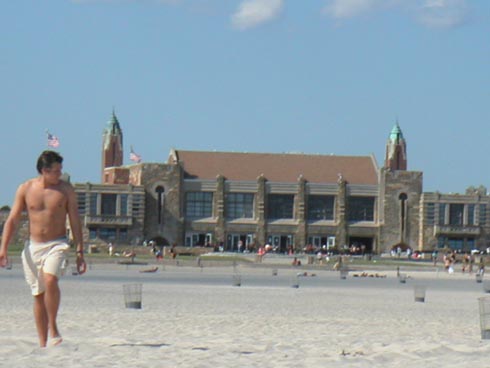 |
|||||||||||||
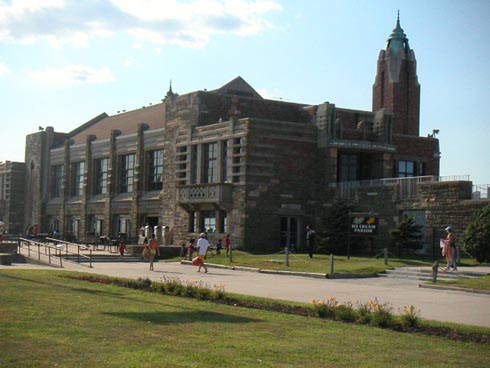 |
|||||||||||||
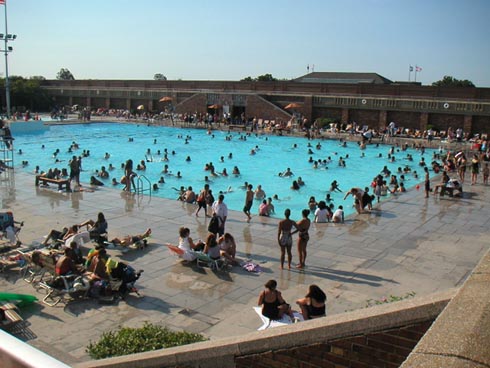 |
|||||||||||||
 |
|||||||||||||
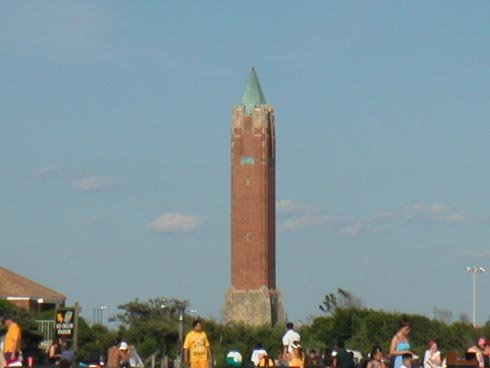 |
|||||||||||||
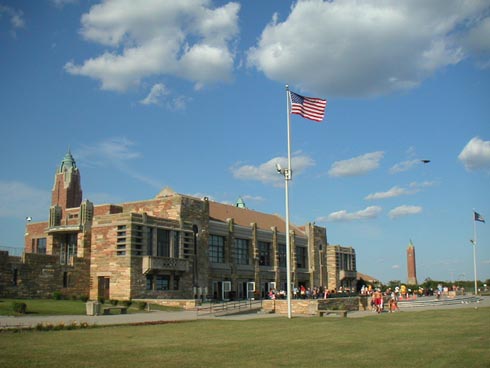 |
|||||||||||||
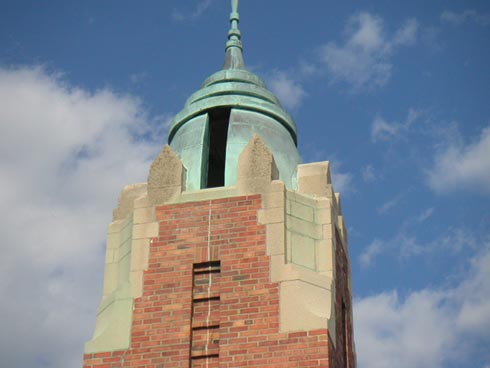 |
|||||||||||||
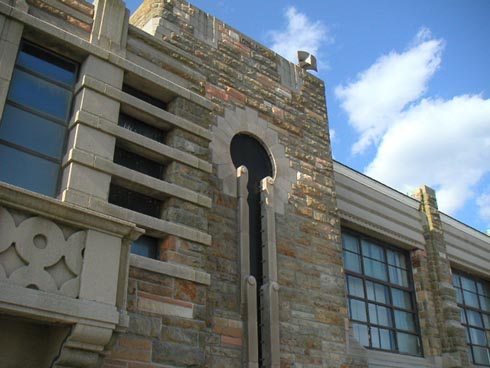 |
|||||||||||||
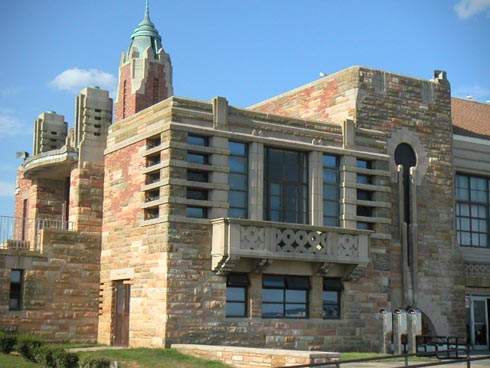 |
|||||||||||||
|
February 6, 2005 King of Beaches Gets a New Title By JOHN RATHER 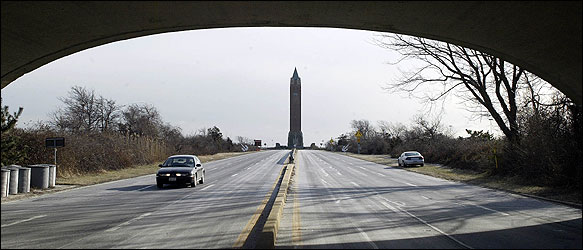 Robert Moses' Jones Beach water tower and the Wantagh Parkway, seen from under one of the bridges he built low to thwart buses. On Wednesday, Bernadette Castro, the commissioner of the New York Office of Parks, Recreation and Historic Preservation, designated the 76-year-old park, its 2,413 acres and six miles of Atlantic Ocean beaches for a listing on the State Register of Historic Places. Ms. Castro simultaneously requested that the National Park Service place the park on the National Register of Historic Places. The park service will almost certainly approve the request, giving Jones Beach, a gigantic regional amenity that over the generations has drawn an estimated 500 million visitors, a level of recognition that had strangely eluded it long after its overarching historic importance became clear. It would become one of more than 4,400 New York listings on the federal register, most for sites far less widely known or visited. The state and federal listings would also encompass the roadways Moses built to connect the park to the mainland and make it accessible for anyone with a car. Sections of the Wantagh, Meadowbrook, Southern State, Ocean, Bay State and Loop parkways nearest the park are included. Once the park is listed, the state government and nonprofit groups will have greater access to federal grants for historic preservation projects. State matching grants and federal tax credits also become available. State officials are hoping for a surge of support for maintaining and restoring the park and its bathhouses, buildings and landscaping to the high aesthetic standards of its original design. Ms. Castro and park officials have plans to create a friends-of-the-park group that would enlist park patrons and others in meeting these goals. "We are already restoring much of what was originally there when the park opened," said Ms. Castro, who lives in Lloyd Harbor. "The listings will set the tone for future stewardship." Ms. Castro said that a first-ever master plan for Jones Beach, with initial financing from a $100,000 state grant, would create an inventory of the park and establish maintenance guidelines to preserve the original, heroic scale of Moses' Beaux-Arts design and Moorish, modern and Art Deco architecture of Ohio sandstone and Barbizon brick, mixed with eclectic and whimsical touches. Nautical themes including mahogany boardwalk railings, now replaced by aluminum railings, and trash barrels disguised as ship funnels and still in use at the park, conveyed to visitors the feeling of being on an ocean liner. Preservationists said the listings and the master plan came at a time when Jones Beach needed to be seen in an historic context. "The most important thing is the management plan," said Charla Bolton, a spokeswoman for the Society for the Preservation of Long Island Antiquities, a nonprofit group in Cold Spring Harbor. "It determines not only how basic maintenance will be done but also ways of caring for buildings so they don't lose important stylistic details." In a report for the society in July, Alexandra Parsons Wolfe, a preservation consultant, said that many details had been lost, particularly during the 1970's and 1980's, because crucial decisions were left to park administrators and employees with no mandate to preserve the park's original design. "Much of what made the park special has slowly and insidiously disappeared due to maintenance and improvement procedures that failed to fully recognize the numerous components that contribute to the park's significance," the report said. The report cited a series of missteps, including installation of cheap outdoor lighting fixtures to replace decorative originals, the misuse of Art Deco-style stone planters as trash barrels, a stripping away of crucial landscaping and flat, featureless aluminum frame replacement windows on the West Bathhouse, architecturally among the most important buildings in the park. The report also noted the loss of major design elements, including reflecting pools on Ocean Parkway west and east of the Jones Beach tower. Taken together, the report said, these and other changes had "seriously compromised the fundamental character of the park." "The park is all about the details," Ms. Wolfe said in an interview. "Having a master plan gives you a better success rate in keeping them. It's very clear and it's in your hands. You know what you are supposed to do and it can be as detailed as you want it to be." The report pointed to a Friendly's restaurant sign posted outside the West Bathhouse as a jarring example of the kind of commercialism Moses, who banned concessionaires from the park, would never have allowed. His vision, Ms. Wolfe said in the report, did not include the "aesthetically incoherent results of commercialism." John Norbeck, the regional director for state parks on Long Island, said the reflecting pools could not be restored because they were a traffic hazard and failed to meet federal and local highway standards. He also said there were no plans to restore mahogany railings on the boardwalk because of the cost and the high maintenance demands of constant refinishing. But J & B Restaurant Partners of Ronkonkoma, which signed a 10-year food concession contract for Jones Beach last year, said it would remove the Friendly's sign. "That sign will never be visible again," said Gregory F. Alagna, the company's director of operations. Ms. Castro said she was aware of the report and had acted on some of its findings. She mentioned the repair of a clock on the West Bathhouse and a $50,000 project to restore a mosaic map of Long Island at the north end of the central mall. "I think the park is wonderful," she said. "I don't feel there is any reason for alarm at all." Mr. Norbeck said that commemorative wooden benches, canvas awnings and trash barrels with the park's original crab emblems have also been added. Laser-cut replicas of original, whimsical directional signs with comic figures in silhouette have also appeared on walkways. Mr. Norbeck said preservation projects in the park were constrained by cost. Jones Beach receives a portion - parks officials said they didn't know how big - of the $33 million annual state appropriation for all state parks on Long Island. (An additional $2.6 million annually from parking fees, $415,000 annually from concessions and more than $3 million in concert proceeds are plowed back into the park.) "We have tried to save as much as we could," he said. "But Moses had an unlimited budget and everything was hand-made and custom-designed." Moses, the first head of the Long Island State Park Commission and an immensely powerful non-elected public official for four decades, visualized Jones Beach in the mid-1920's as a place where city dwellers with cars could come for a day in the sun. But the sheer grandeur of the park's design and of the high quality materials used to build it, mixed with lighthearted signs and an architecture that weaved in the suggestion that it was a place for wholesome fun, made Jones Beach an entirely new kind of park. It was also the first major park in the country to recognize the primacy of the automobile. When the park opened on Aug. 4, 1929, it was an immediate success. Expansions and more building followed, even as the Depression set in. But Moses' direction that overpasses on the Southern State Parkway be too low for buses - a design that also became part of the later Northern State Parkway - coupled with a permit system in the park's earliest days that made it difficult for buses to park at Jones Beach even when they got there using older roads gave Jones Beach a Jim Crow taint. In his book "The Power Broker," Moses' biographer, Robert A. Caro, recounts that Moses kept temperatures low in the bathhouse pools because he believed blacks could not endure the cold water and would stay away. Park attendance has declined from more than eight million in 1991. George Gorman, the director of administration and operations for state parks on Long Island, said that in the past several years annual attendance was steady at about six million. As Jones Beach moves toward historic status, some preservationists are urging that the state ask the federal government to designate it as a national historic landmark, a step above the national register. "It is a site really of national if not international significance," said Ms. Bolton of the Society for the Preservation of Long Island Antiquities. But the state will not seek the higher status "That may be a consideration down the line," said Catherine N. Jimenez, a spokeswoman for the state parks department. She said additional documentation would be needed. Only about 3 percent of the 78,320 listings on the national register are also national historic landmarks, a designation made by the Secretary of the Interior upon the recommendation of the National Park Service for sites deemed to have national significance and exceptional historic importance. More than a tenth, or 252, of the country's fewer than 2,500 national historic landmarks are situated in New York. The list includes the Adirondacks State Preserve, the Brooklyn Bridge, Carnegie Hall, the Erie Canal and the Empire State Building as well as lesser-known sites like the John Brown farm and gravesite near Lake Placid. On Long Island, the list includes the First Presbyterian Church in Sag Harbor, also called the Old Whalers Church; Fort Corchaug and the Old House in Cutchogue; the sloop Modest and the Rudolph Oyster House in West Sayville; the William Sidney Mount House in Stony Brook; the Jackson Pollock House in East Hampton and the Fort Massapeag Archeological Site in Oyster Bay. Sagamore Hill in Oyster Bay, the home of Theodore Roosevelt, is a national historic site, a designation that requires approval from Congress and the president. The Statue of Liberty is a national monument, a presidential designation. Copyright 2005 The New York Times Company |
|||||||||||||
|
Jones Beach, the Marvel
by the Sea By Bill Bleyer Staff Writer
The water fountains were operated by miniature ships' steering wheels, the trash cans were hidden inside ship funnel ventilators and the employees were dressed like sailors. The 2,413-acre state park featured swimming in the ocean surf, in a bay and in heated pools, and a variety of other activities. Patrons -- and there were 1.5 million of them during the first full year of operation in 1930 -- could also enjoy handball courts, deck tennis and shuffleboard courts, an outdoor roller rink, archery, softball, fishing docks, rowboat rentals, an 18-hole pitch-and-putt golf course, dancing, and other sports and entertainment programs. There were even solaria for nude sunbathers and electric bottle warmers for mothers caring for their babies. As time and tide have washed across the beach over the decades, much has changed. The nautical water fountains and uniforms, the nude sunbathing and the bottle warmers are long gone, and other facilities and programs have been lost to budget cuts or changing times. Among the things eliminated were handball courts, archery ranges, and umbrella, beach chair and rowboat rentals. The outdoor roller rink, unused for a decade, may be converted to lighted volleyball courts. Parking Field 9 was closed in 1977 because of beach erosion. But other facilities and programs have been added as the park operation expanded. Since Gov. Franklin D. Roosevelt dedicated Jones Beach, the West End complex has been developed with two large parking fields, although West End 1 was closed in 1991 because of budget cuts. A pool was added in the East Bathhouse in the 1960s. The 8,200-seat Jones Beach Theatre was added in 1952 -- at first presenting musicals and then shifting to rock concerts. For this summer, the theater's seating capacity is being expanded to 14,354. The pitch-and-putt course has also been expanded and a miniature golf course was opened in the late 1970s. Basketball courts were added. Joseph Lescinski, the Jones Beach superintendent, said the crowds have changed as well. When the beach first opened, most visitors came from New York City. Now there is a mix of city and suburban users. ``Our weekday crowd tends to be primarily a Long Island crowd; our weekend crowd tends to be a mix of Long Island and the city.'' In a typical year, the park attracts 7 million to 8 million people -- about 5 million of them during the summer. The single-day attendance record was set on July 4, 1995, when about 275,000 hit the beach. On an average sunny July Sunday, the park attracts 150,000 to 200,000. The parking fee, initially 50 cents weekends and 25 cents weekdays, has risen to $5. The park is run by about 75 year-round permanent employees with about 850 to 900 seasonal workers in the summer. The peak staffing back in the early '60s was about 2,000 employees. On Jones Beach's first opening day, three parking fields were open for 10,000 cars. Now there are a dozen that can accommodate 23,500 cars. The history of Jones Beach and the other Long Island state parks is chronicled in a permanent exhibit called ``Castles in the Sand,'' in the East Bathhouse. It displays photographs and memorabilia from the early days of the park system. There are maps and plans from park construction projects, old uniforms worn by employees, and videos of the park in the 1940s and 1950s, including snippets from a movie titled ``The Girl From Jones Beach.'' The exhibit is open April 1 to June 19 from 10 a.m. to 4 p.m. seven days a week; from June 20 to Sept. 7, noon to 8 p.m.; Sept. 8 to Oct. 12, 10 a.m. to 4 p.m., seven days a week; and from Oct. 13 to March 31, Saturdays, Sundays and holidays, 10 a.m to 4 p.m. The admission is $1. Copyright © 2004, Newsday, Inc. |
|||||||||||||
But an advocacy group is pushing renovations to return the destination to its former glory BY BILL BLEYER STAFF WRITER Posted August 4, 2004 As state officials celebrate the 75th anniversary of Jones Beach today with birthday cake and special activities, a respected preservation group is focusing attention on the loss of many historic architectural details that made the park unique. The Society for the Preservation of Long Island Antiquities has completed a two-year study that lists numerous examples of original design elements from Robert Moses' vision that have been lost or compromised by unsympathetic alterations or repairs. They range from the removal of reflecting pools along Ocean Parkway, and the mahogany boardwalk railing, to wooden windows and doors replaced by modern aluminum designs, to improper patching of original tile mosaics. The report also points out that most of the problems were caused by previous park administrations and credits Parks Commissioner Bernadette Castro and her staff for working to reverse the deterioration. Castro pledged yesterday to carry out key recommendations of the report, such as preparing a master plan to better preserve the park and getting Jones Beach listed on the National Register of Historic Places. The designation would have no affect on the public's use of the beach but would require repairs and maintenance to be historically accurate. After those steps are completed, Castro said, additional recommendations will be considered such as declaring Jones Beach a state historic park like Planting Fields so it will be eligible for more historic management expertise from the parks department. "The problem with Jones Beach is that no one has seen it as historic and there has been a long history of unsympathetic changes that have eroded Robert Moses' design features," said SPLIA Director Robert MacKay. "Very much Jones Beach is the sum of its details. It's in the signs, the water fountains, the detailing around the buildings." Castro said her goal is to have the park on the National Register by the end of the year. She said no master plan has been prepared because the state didn't have the $100,000 it would cost, but she committed to completing the document within two years. "Preservation is very important to this administration," Castro said. The report was prepared by historic preservation consultant Alexandra Parsons Wolfe of Douglaston. During a tour of the park this week, Wolfe pointed out at the West Bathhouse where the concrete has cracked, allowing steel reinforcing bars to show through; where glass panes are missing, allowing birds inside the structure; and where mismatching concrete and bricks have been used to patch gaps in the walls. The clock on the exterior wall is missing its hands. The awning is missing from around the pool area and the fencing has been altered. Decorative moldings have been removed from the exterior. The report summarizes the positive steps the state has taken in the past four years at the park. Thirteen interpretive signs have been installed on the boardwalk, as well as replicas of early wooden benches. A permanent park history exhibit, "Castles in the Sand," was placed in the East Bathhouse. This year, replicas of the original striped canvas awnings on the Central Mall buildings were installed. The park also placed more steamship funnel covers on boardwalk garbage cans, erected replica metal silhouette signs and re-created some original landscaping. Castro said additional historic interpretation signs will be erected around the park. She added that $50,000 has been set aside to repair the historic mosaics on the Central Mall. Castro added that some missing details, such as the hands on the West Bathhouse clock, also will be replaced. "It shows the public we do care about preservation," she said. Copyright © 2004, Newsday, Inc. |
|||||||||||||
Jones Beach State Park
HistoryJones Beach State Park, most renowned of all Long Island State Parks, derives its name from Major Thomas Jones who came to Long Island in 1692, built, near Massapequa, the first brick house on Long Island and eventually acquired a total of 6,000 acres. Apparently he thought he also owned a part of what is now Jones Beach because around the year of 1700 he established a whaling station on the outer beach near the site of the present park. Jones died in 1713.
The TheaterThe theater was reconstructed in 1991 and 1992 under contract with promoter Ron Delsener, it is a outstanding facility that can seat 11,200 persons. It has become one of the top rated concert stadiums hosting world famous performers, along with upgraded seating, restrooms & service stations The TowerThe Jones Beach tower, now a familiar Jones Beach State Park landmark, was modeled on the campanile of St. Mark's Cathedral in Venice. It is 200 feet high, made of brick and stone, and houses a 315,000 gallon water tank for storage of water from four deep wells, each over 1,000 feet deep. West End AreaThe West End Area of the park features many undeveloped areas that are home to a variety of migratory birds and natural plants. It also provides wonderful surf fishing opportunities as well as surfing by the jetty. The boat basin contains 76 slips that are available free of charge for day visitors coming by boat. Facilities and ServicesPark comprises 2,413 acres 6-1/2 miles of ocean beach frontage, with a 1/2 mile frontage developed for still water bathing. Park OperationsPark is open year-round, however, activities vary according to the season. For more information about the park operating schedule and special activities, call (516) 785-1600. For group outing (picnic) or youth (example daycamp) outing applications, please call (516) 669-1000 ext. 223. DirectionsThirty-three (33) miles from Manhattan via Meadowbrook Parkway South and Wantagh Parkway South to the park. PO Box 1000 Wantagh, New York 11793 (516) 785-1600 |
|||||||||||||
|
Jones Beach represents a new kind of park in
the 1920s. Located on Long Island it functioned as a regional park for
people living in Manhattan. It was only accessible by automobile via
limited access parkways. The beautiful but somewhat fragile beach site
was carefully designed to provide well-planned facilities that would
serve the needs of families. From the large parking lots paths led to
large recreational buildings that provided restaurants, cafes, creches,
and changing rooms for both sexes. These buildings provided direct
access to the most stable beach areas. Jones Beach was a park designed
for recreational uses. While undisturbed natural areas could have
provided opportunities for passive contact with Nature, in the 19th
century tradition, this was not a major objective. The park was also
socially exclusionary, since buses could not negotiate the low
underpasses. Poor families that did not own cars could only travel to
distant areas by train or by bus. The buildings at Jones Beach established new standards of excellence in the provision of facilities in public parks. Indeed, they were not that dissimilar from what might be found in private country clubs. The buildings were beautifully crafted in masonry with generous terraces, and were conceived as palaces for the people. |
|||||||||||||
In more than 30 years of public service to the city of New York and New York State, Robert Moses achieved a record in building highways, parks, bridges, and recreation areas. In 1919, Governor Alfred E. Smith appointed Moses the Chief of Staff of the New York State Reconstruction Commission. In 1920, he presented a plan for the state-wide improvement of parks and highways. In 1924 Moses was named the president of the council and the chairman of Long Island State Parks Commission. He was appointed to these positions by Governors Franklin D. Roosevelt, Herbert H. Lehman and Thomas E. Dewey. Among his hundreds of projects, Moses was responsible for the creation of Jones Beach, Robert Moses State Park, Hither Hills State Park, Montauk State Park, Oak Beach, Wildwood State Park, Sunken Meadow State Park. As head of the Triborough Bridge and Tunnel Authority (1946-1968), he was responsible for building the Triborough and Verrazano-Narrows bridges. Robert Moses was responsible for many great building projects and was often called the "master builder." He forever changed the shape of Long Island by creating some of the world's finest public recreation spots. |
|||||||||||||
|
links |
Robert Moses | ||||||||||||